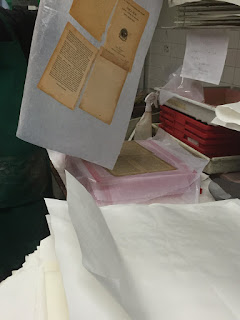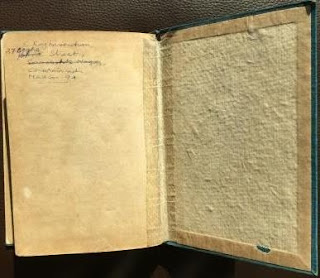There are ways and means by which the paper can be strengthened. One such method is to apply a coat of Gelatin onto the paper, which improves the strength and stability of the paper.

Preparation of the paper
The starting point is the float washed paper that has been left to be air dried on archival blotting paper. Each folio is made up of 4 pages. Four such folios make up a section in this book.
NOTE: Notice how the inner folios (on the left) are intact, whereas the outer folios of the section are frayed or split at the fold. But we will deal with this repair comes later.

Prepare the Size
We prepare a gelatin size (Size is a thickened solution) using the following raw material:
G9391-100g Gelatin, from Bovine skin.
Type B Bioregeant powder
PCode 1001090276
Sourced from Sigma-Aldritch, St. Louis, USA
Take a liter of (warm to hot) water and mix about 50g(?) of Gelatin. Stir well until it becomes a clear solution.
Use a brush such as the one in the picture (A cheap distemper brush will do), about 3 - 4 inches wide, and very thin on the side. This will allow the brush to retain minimum amount of gelatin, and will apply a thin, uniform coat of gelatin on the paper. A thicker brush will retain a lot more fluid and will dump the gelatin fluid on the paper.
Relax the Paper
 To begin with, we need to relax the paper. A little bit of moisture in the paper immediately relaxes the paper. Spray a fine mist of water on the open folios on the blotting paper. A very fine mist is preferred. Notice how the paper curls up (along the grain direction) immediately on coming in contact with moisture!
To begin with, we need to relax the paper. A little bit of moisture in the paper immediately relaxes the paper. Spray a fine mist of water on the open folios on the blotting paper. A very fine mist is preferred. Notice how the paper curls up (along the grain direction) immediately on coming in contact with moisture!
Flip the folios carefully, and spray a fine mist of water on the other side as well. This will uncurl the paper and will relax the folios, so that it rests evenly on the blotting paper
Now you are ready to apply a coat of gelatin on the paper, to strengthen it.
Apply the Gelatin Coat
 Dip the brush into the gelatin size, and drain the excess. Holding the paper, apply an even and thin coat on the paper. Once the entire surface of the paper has been covered with vertical brush-strokes, apply a coat with horizontal brush-strokes.
Dip the brush into the gelatin size, and drain the excess. Holding the paper, apply an even and thin coat on the paper. Once the entire surface of the paper has been covered with vertical brush-strokes, apply a coat with horizontal brush-strokes.
Apply the gelatin coat on all the folios that require strengthening. Once the coat has been applied, flip the folios on the blotting paper, and apply the gelatin coat on the other side. Once done, let these folios air-dry.
 The Result
The Result This is how the folios look after it has air dried. Even for the naked eye, the paper appears stronger and more stable.
Once dry, these folios will need to be re-assembled into sections that can be flattened out and resewn into a book block.

Trouble Shooting
When the paper has air dried, it should just lift off the blotting paper. But this one seems stuck! I find out that I have applied a 'very generous' coat of gelatin, and this means that the folios have gotten stuck to the blotting paper. In this case, all four folios are stuck!
What to do?
I am asked to apply a fine mist of water on the folios. As the paper absorbs moisture, the paper should get unstuck. That, at least, is the theory.
 But even after spraying water once or twice, the folios are not getting loose. I am forced to the step up my action. I cut the blotting paper into four separate parts, each with one folio. I float wash these sheets, interleaved with layers of bondina. Give it about 10 - 15 minutes.
But even after spraying water once or twice, the folios are not getting loose. I am forced to the step up my action. I cut the blotting paper into four separate parts, each with one folio. I float wash these sheets, interleaved with layers of bondina. Give it about 10 - 15 minutes.
The water soaks into the folios and the blotting paper, and lo! the papers now separate out easily enough. I gently lay out these wet folios to air dry on a new set of blotting sheets.
The papers have now been float washed and strengthened. But as we can see, many folios are still split at the spine, and would need to be rejoined, before the folios can be folded and resewn. But we are getting there... One step at a time!






































